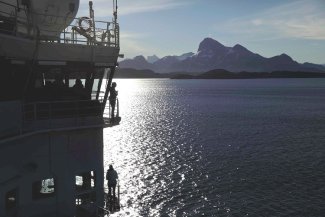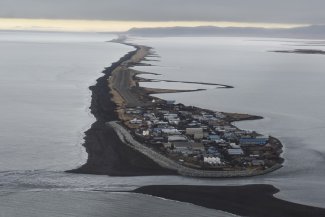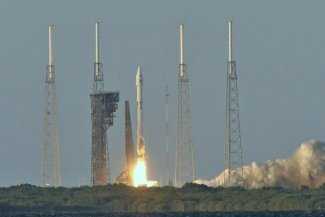In this image from August 2019, the Russian Arktika-class nuclear-powered icebreaker 50 Let Pobedy docks near the North Pole in the Arctic region.
Like the new space race, the current push into the territories north of the Arctic Circle increasingly resembles the Wild West, both in terms of the appetizing terrain it presents for exploitation and the unrestrained competition currently taking place between adventurers and entrepreneurs of all kinds. And, at present, no sufficiently solid legal framework currently exists to prevent the potential problems that lie ahead, include the possibility of direct violent clashes.
None other than the climate crisis is responsible for unleashing this now unstoppable process. The Arctic is warming at a rate three times faster than the average for the rest of the planet. This means serious sustainability problems, above all for the 4.2 million people living in the region and the fauna and flora of this demanding and delicate environment, and, by extension, for the rest of the planet.
But the disappearance of permanent ice sheets also means the opening of maritime routes hitherto effectively closed for most of the year (the Northwest Passage and the Russian North Sea route) and greater accessibility to potential mineral, fishing and energy resources.
In commercial terms, the northern route between Hamburg and Shanghai is 4,900km shorter than the route through the Suez Canal. That means not only about ten fewer days of sailing time compared to the current average of 34-40 days via Suez (the need for icebreakers, bad weather and potential obstacles do not allow for the same speeds that can be achieved in warm waters), but also savings in fuel and personnel costs, less pollution and lower insurance costs, as the areas are (for the time being) free of piracy.
In 2013, 71 passages were made through the Arctic route, transporting a million tonnes (compared with 17,000 transits through the Suez Canal carrying more than 915 million tonnes). By 2020, that number had risen to 33 million tonnes.
While Suez continues to be the favoured shipping route, accidents like this year’s obstruction of the canal caused by the Ever Given, coupled with the progressive melting of the Arctic, have led Russia to set targets for the Northern Sea Route to be fully operational by 2035. Last February, liquefied natural gas (LNG) carrier Christophe de Margerie completed the first ever mid-winter crossing of the route, travelling from Sabetta, Russia to Jiangsu, China.
With more than 60 per cent of the Arctic region and 80 per cent of its population located in Russian territory, no other country is better positioned to benefit from the potential boom in business. And while the Arctic route is unlikely to replace the Suez Canal anytime soon until the necessary infrastructure is built along Arctic coasts (ports, railways, electricity grids, airports, etc., both to meet the needs of ships and crews in transit, and to move goods between producers and consumers), the possibility must be taken into account now. Russia estimates that some US$200 billion (€165 billion) would be needed by to make the route competitive by 2050, US$87 billion (€72 billion) of which would have to be invested by 2024. As of last year, only US$14 billion (€11.5 billion) had been accounted for in real investments.
As for the potential wealth stored underground, the Arctic holds an estimated 30 per cent of the world’s undiscovered natural gas and 13 per cent of its undiscovered oil. Russia, which in August 2007 planted its flag on the seabed 4,261 metres beneath the North Pole, once again stands to be the largest beneficiary, given that 80 per cent of these resources are believed to be in territory that Moscow claims as its own. But lacking infrastructure once again poses an obstacle to this enormous potential. While some projects are already underway, such as the Yamal liquefied natural gas plant, neither Rosneft nor Gazprom have yet been encouraged, pending the incentives and tax advantages that the Kremlin may offer.
Who is managing the interests at stake?
While long-term success remains uncertain, the pressure and greed of various actors interested in short-term gain is increasing (after all, former US president Donald Trump even announced his intention to buy Greenland in 2019). To date, only one intergovernmental body has been set up to manage the interests at stake, and it is poorly equipped to do so. Established 25 years ago by the 1996 Ottawa Declaration, the Arctic Council was intended to promote cooperation on issues such as environmental protection and sustainable development, but explicitly excluded military and security concerns. The Council was initially comprised of six Arctic indigenous communities, along with Canada, Denmark, Finland, Iceland, Norway, Russia, Sweden and the United States. Since May 2013, China, South Korea, India, Italy, Japan, Singapore and South Korea have been added as observer member states.
At the Council’s most recent meeting in Reykjavik on 19 and 20 May, Russia, which assumed the rotating presidency for the next two years, unveiled for the first time in the Council’s history a strategic plan for the next ten years. The plan focuses on combatting global warming, preserving peace and cooperation in the fight against climate change, science and, for the first time, it discreetly includes security and defence, with a concrete proposal to restart regular meetings between the military chiefs of the member states (suspended since Russia’s annexation of Crimea in 2014) and another to hold a summit of heads of state and government during Russia’s presidency.
The militarisation of the region is becoming increasingly evident, and Russia appears to be taking the lead: the country plans to reactivate former Soviet bases, such as the one in the Novaya Zemlya archipelago, and to modernise the Northern Fleet, which accounts for two-thirds of its entire war fleet.
It is also locating radar stations on the islands of Novaya Zemlya, on Wrangel Island and at Cape Schmidt (in the far east), and establishing two motorised brigades based in Murmansk (near Norway) and in the Yamalo-Nenets Autonomous Okrug. In addition, it is expanding its Nagurskoye air base and building two permanent bases on the Alexandra Land and Kotelny islands, designed not so much for combat as for monitoring the area and flying the Russian flag, with the understanding that the future will bring increasing disputes over national sovereignty and property rights.
At the same time, the United States, aware of its disadvantage (it has no ports north of the Bering Strait, has not yet signed the UN Convention on the Law of the Sea, and only has three icebreakers compared to Russia’s more than 40), is attempting to overcome Canada’s reluctance to allow it to exercise greater control over the Northwest Passage, which would guarantee it greater freedom of movement towards the Arctic.
The US is also increasing cooperation with the Nordic countries of Europe. Last February, it deployed B-1B strategic bombers on Norwegian territory for the first time, and from 7 to 18 June of this year it once again participated in the Arctic Challenge Exercise (ACE21), in which Norway played host to more than 70 aircraft and more than 3,000 troops from Denmark, Finland, Germany, the Netherlands, Sweden, the United Kingdom and the United States, in addition to NATO AWACS aircraft. This is the fifth time since 2013 that the Arctic Challenge Exercise has taken place and, despite the restrictions imposed by the Covid-19 pandemic, it has made clear the shared interest in improving their systems of cooperation – all with Russia in mind.
As the region’s various players race to secure strategic advantage, all while failing to sufficiently address climate change or prevent the conflicts that are sure to ensue, the situation is becoming increasingly challenging.













